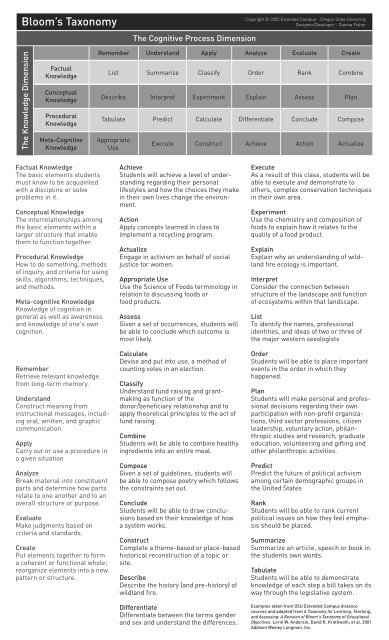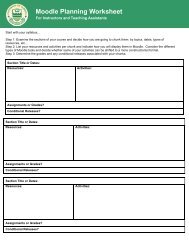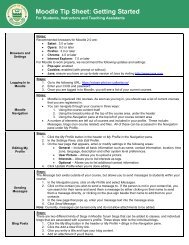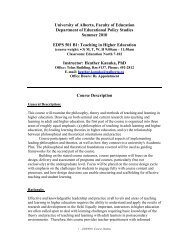TLS Blooms Taxonomy Working Model Tools.pdf - Centre for ...
TLS Blooms Taxonomy Working Model Tools.pdf - Centre for ...
TLS Blooms Taxonomy Working Model Tools.pdf - Centre for ...
Create successful ePaper yourself
Turn your PDF publications into a flip-book with our unique Google optimized e-Paper software.
Bloom’s <strong>Taxonomy</strong><br />
The Cognitive Process Dimension<br />
Copyright © 2005 Extended Campus - Oregon State University<br />
Designer/Developer - Dianna Fisher<br />
The Knowledge Dimension<br />
Factual<br />
Knowledge<br />
Conceptual<br />
Knowledge<br />
Procedural<br />
Knowledge<br />
Meta-Cognitive<br />
Knowledge<br />
Remember<br />
List<br />
Describe<br />
Tabulate<br />
Appropriate<br />
Use<br />
Understand Apply Analyze Evaluate Create<br />
Summarize Classify Order<br />
Rank Combine<br />
Interpret Experiment Explain Assess Plan<br />
Predict Calculate Differentiate Conclude Compose<br />
Execute Construct Achieve Action Actualize<br />
Factual Knowledge<br />
The basic elements students<br />
must know to be acquainted<br />
with a discipline or solve<br />
problems in it.<br />
Conceptual Knowledge<br />
The interrelationships among<br />
the basic elements within a<br />
larger structure that enable<br />
them to function together.<br />
Procedural Knowledge<br />
How to do something, methods<br />
of inquiry, and criteria <strong>for</strong> using<br />
skills, algorithms, techniques,<br />
and methods.<br />
Meta-cognitive Knowledge<br />
Knowledge of cognition in<br />
general as well as awareness<br />
and knowledge of one's own<br />
cognition.<br />
Remember<br />
Retrieve relevant knowledge<br />
from long-term memory.<br />
Understand<br />
Construct meaning from<br />
instructional messages, including<br />
oral, written, and graphic<br />
communication.<br />
Apply<br />
Carry out or use a procedure in<br />
a given situation<br />
Analyze<br />
Break material into constituent<br />
parts and determine how parts<br />
relate to one another and to an<br />
overall structure or purpose.<br />
Evaluate<br />
Make judgments based on<br />
criteria and standards.<br />
Create<br />
Put elements together to <strong>for</strong>m<br />
a coherent or functional whole;<br />
reorganize elements into a new<br />
pattern or structure.<br />
Achieve<br />
Students will achieve a level of understanding<br />
regarding their personal<br />
lifestyles and how the choices they make<br />
in their own lives change the environment.<br />
Action<br />
Apply concepts learned in class to<br />
implement a recycling program.<br />
Actualize<br />
Engage in activism on behalf of social<br />
justice <strong>for</strong> women.<br />
Appropriate Use<br />
Use the Science of Foods terminology in<br />
relation to discussing foods or<br />
food products.<br />
Assess<br />
Given a set of occurrences, students will<br />
be able to conclude which outcome is<br />
most likely.<br />
Calculate<br />
Devise and put into use, a method of<br />
counting votes in an election.<br />
Classify<br />
Understand fund raising and grantmaking<br />
as function of the<br />
donor/beneficiary relationship and to<br />
apply theoretical principles to the act of<br />
fund raising.<br />
Combine<br />
Students will be able to combine healthy<br />
ingredients into an entire meal.<br />
Compose<br />
Given a set of guidelines, students will<br />
be able to compose poetry which follows<br />
the constraints set out.<br />
Conclude<br />
Students will be able to draw conclusions<br />
based on their knowledge of how<br />
a system works.<br />
Construct<br />
Complete a theme-based or place-based<br />
historical reconstruction of a topic or<br />
site.<br />
Describe<br />
Describe the history (and pre-history) of<br />
wildland fire.<br />
Differentiate<br />
Differentiate between the terms gender<br />
and sex and understand the differences.<br />
Execute<br />
As a result of this class, students will be<br />
able to execute and demonstrate to<br />
others, complex conservation techniques<br />
in their own area.<br />
Experiment<br />
Use the chemistry and composition of<br />
foods to explain how it relates to the<br />
quality of a food product.<br />
Explain<br />
Explain why an understanding of wildland<br />
fire ecology is important.<br />
Interpret<br />
Consider the connection between<br />
structure of the landscape and function<br />
of ecosystems within that landscape.<br />
List<br />
To identify the names, professional<br />
identities, and ideas of two or three of<br />
the major western sexologists<br />
Order<br />
Students will be able to place important<br />
events in the order in which they<br />
happened.<br />
Plan<br />
Students will make personal and professional<br />
decisions regarding their own<br />
participation with non-profit organizations,<br />
third sector professions, citizen<br />
leadership, voluntary action, philanthropic<br />
studies and research, graduate<br />
education, volunteering and gifting and<br />
other philanthropic activities.<br />
Predict<br />
Predict the future of political activism<br />
among certain demographic groups in<br />
the United States<br />
Rank<br />
Students will be able to rank current<br />
political issues on how they feel emphasis<br />
should be placed.<br />
Summarize<br />
Summarize an article, speech or book in<br />
the students own words.<br />
Tabulate<br />
Students will be able to demonstrate<br />
knowledge of each step a bill takes on its<br />
way through the legislative system.<br />
Examples taken from OSU Extended Campus distance<br />
courses and adapted from A <strong>Taxonomy</strong> <strong>for</strong> Learning, Teaching,<br />
and Assessing: A Revision of Bloom's <strong>Taxonomy</strong> of Educational<br />
Objectives. Lorin W. Andersin, David R. Krathwohl; et al. 2001<br />
Addison Wesley Longman, Inc.
<strong>Working</strong> <strong>Model</strong> of Thinking Processes<br />
Copyright © Donald, J.G. (2002).<br />
Learning to Think: Disciplinary Perspectives. San Francisco, CA: Jossey Bass.<br />
Description Selection<br />
Representation Inference Synthesis<br />
Verification<br />
• State functions<br />
• State assumptions<br />
• State facts<br />
• State conditions<br />
• Identify context<br />
• Choose relevant<br />
in<strong>for</strong>mation<br />
• Identify critical<br />
elements<br />
• Identify critical<br />
relations<br />
• Order in<strong>for</strong>mation<br />
in importance<br />
• Recognize organizing<br />
principles<br />
• Organize elements<br />
and relations<br />
• Illustrate elements<br />
and relations<br />
• Modify elements<br />
and relations<br />
• Discover new<br />
relations between<br />
elements<br />
• Discover new<br />
relations between<br />
relations<br />
• Discover<br />
equivalences<br />
• Categorize<br />
• Order<br />
• Change perspective<br />
• Hypothesize<br />
• Combine parts<br />
to <strong>for</strong>m a whole<br />
• Elaborate<br />
• Generate<br />
missing links<br />
• Develop course<br />
of action<br />
• Compare<br />
alternative<br />
outcomes<br />
• Compare<br />
outcome to<br />
standard<br />
• Judge validity<br />
• Use feedback<br />
• Confirm<br />
results<br />
Methods<br />
Expertise (E)<br />
Well-developed representation of<br />
knowledge, action schemas<br />
Hermeneutics (H)<br />
Interpretation; construction of textual<br />
meaning through a dialectic between<br />
understanding and explanation<br />
Critical Thinking (CT)<br />
A reasoned or questioning approach in<br />
which one examines assumptions and<br />
seeks evidence<br />
Problem Solving (PS)<br />
Steps <strong>for</strong> <strong>for</strong>mulating a problem,<br />
calculating and verifying the logic used<br />
Scientific Method (SM)<br />
Objective methods, replicability of<br />
findings, skepticism<br />
Thinking Processes & Behaviors<br />
DESCRIPTION (PS, SM)<br />
Delineation or definition of a<br />
situation or <strong>for</strong>m of a thing.<br />
Identify context (E)<br />
Establish surrounding environment<br />
to create a total picture.<br />
State conditions<br />
State essential parts, prerequisites,<br />
or requirements.<br />
State facts<br />
State known in<strong>for</strong>mation, events that<br />
have occurred.<br />
State functions<br />
State normal or proper activity of a<br />
thing or specific duties.<br />
State assumptions (CT)<br />
State suppositions, postulates, or<br />
propositions assumed.<br />
State goal<br />
State the ends, aims, objectives.<br />
SELECTION (PS)<br />
Choice in preference to another or<br />
others.<br />
Choose relevant in<strong>for</strong>mation (E)<br />
Select in<strong>for</strong>mation that is pertinent<br />
to the issue in question.<br />
Order in<strong>for</strong>mation in importance (E)<br />
Rank, arrange in importance or<br />
according to significance.<br />
Identify critical elements<br />
Determine units, parts, components<br />
that are important.<br />
Identify critical relations<br />
Determine connections between<br />
things that are important.<br />
REPRESENTATION (PS)<br />
Depiction or portrayal through<br />
enactive, iconic, or symbolic means.<br />
Recognize organizing principles<br />
Identify laws, methods, rules that<br />
arrange in a systematic whole.<br />
Organize elements and relations<br />
Arrange parts, connections between<br />
things into a systematic whole.<br />
Illustrate elements and relations<br />
Make clear by examples the parts,<br />
connections between things.<br />
Modify elements and relations<br />
Change, alter, or qualify the parts,<br />
connections between things.<br />
INFERENCE (E, H CT, PS)<br />
Act or process of drawing conclusions<br />
from premises or evidence.<br />
Discover new relations between<br />
elements<br />
Detect or expose connections<br />
between parts, units, components.<br />
Discover new relations between<br />
relations<br />
Detect or expose connections<br />
between connections of things.<br />
Discover equivalences<br />
Detect or expose equality in value,<br />
<strong>for</strong>ce, or significance.<br />
Categorize<br />
Classify, arrange into parts.<br />
Order<br />
Rank, sequence, arrange methodically.<br />
Change perspective<br />
Alter view, vista, interrelations,<br />
significance of facts or in<strong>for</strong>mation.<br />
Hypothesize<br />
Suppose or <strong>for</strong>m a proposition as a<br />
basis <strong>for</strong> reasoning.<br />
SYNTHESIS (PS)<br />
Composition of parts or elements<br />
into a complex whole.<br />
Combine parts to <strong>for</strong>m a whole<br />
Join, associate elements, components<br />
into a system or pattern.<br />
Elaborate<br />
Work out, complete with great detail,<br />
exactness, or complexity.<br />
Generate missing links<br />
Produce or create what is lacking in a<br />
sequence; fill in the gap.<br />
Develop course of action<br />
Work out or expand the path, route,<br />
or direction to be taken.<br />
VERIFICATION (E, H CT, PS, SM)<br />
Confirmation of accuracy, coherence,<br />
consistency, correspondence.<br />
Compare alternative outcomes<br />
Examine similarities or differences of<br />
results, consequences.<br />
Compare outcome to standard<br />
Examine similarities, differences of<br />
results based on a criterion.<br />
Judge validity<br />
Critically examine soundness,<br />
effectiveness, by actual fact.<br />
Use feedback<br />
Employ results to regulate, adjust,<br />
adapt.<br />
Confirm results<br />
Establish or ratify conclusions,<br />
effects, outcomes, products.






